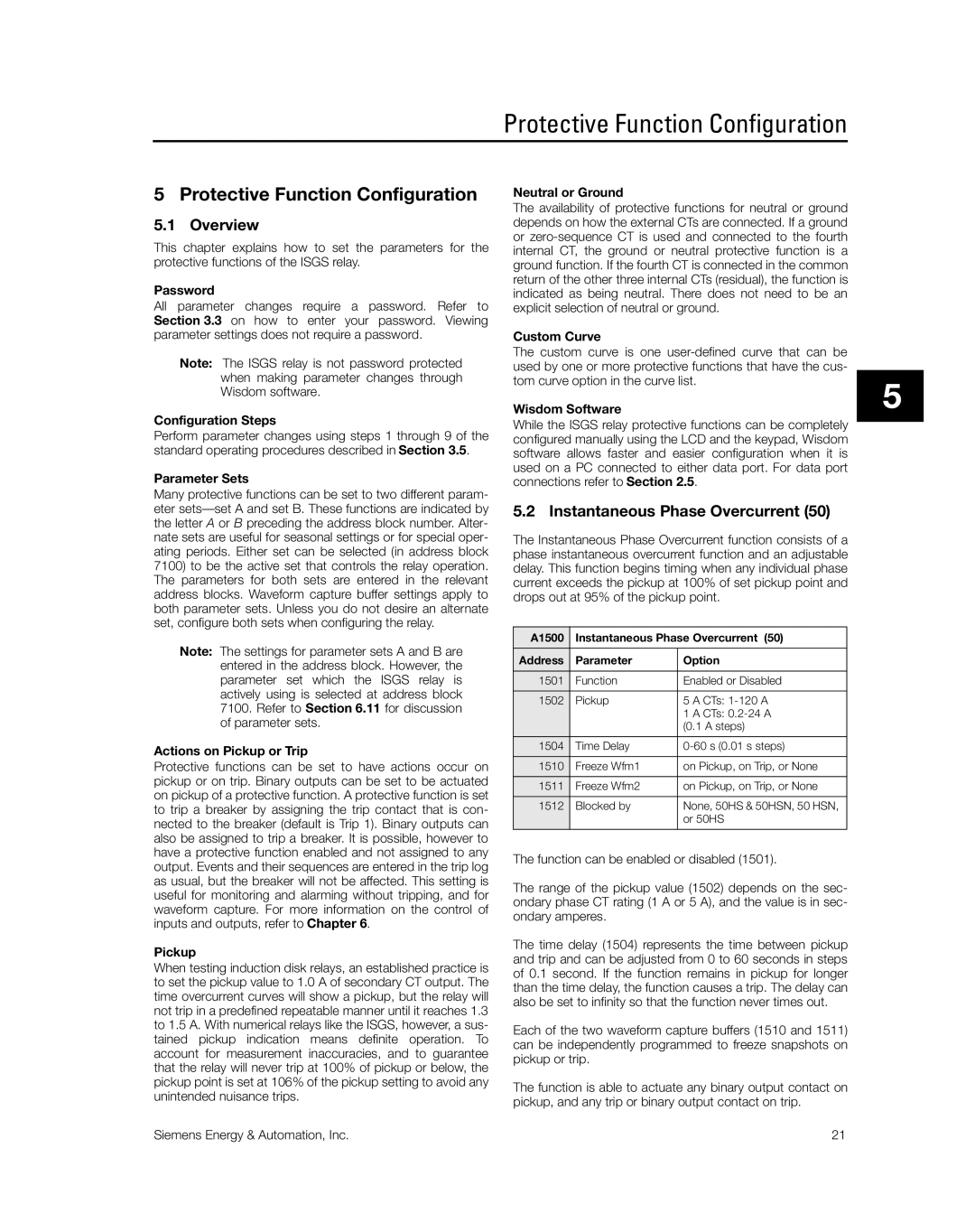
Protective Function Configuration
5 Protective Function Configuration
5.1 Overview
This chapter explains how to set the parameters for the protective functions of the ISGS relay.
Password
All parameter changes require a password. Refer to Section 3.3 on how to enter your password. Viewing parameter settings does not require a password.
Note: The ISGS relay is not password protected when making parameter changes through Wisdom software.
Configuration Steps
Perform parameter changes using steps 1 through 9 of the standard operating procedures described in Section 3.5.
Parameter Sets
Many protective functions can be set to two different param- eter
Note: The settings for parameter sets A and B are entered in the address block. However, the parameter set which the ISGS relay is actively using is selected at address block 7100. Refer to Section 6.11 for discussion of parameter sets.
Actions on Pickup or Trip
Protective functions can be set to have actions occur on pickup or on trip. Binary outputs can be set to be actuated on pickup of a protective function. A protective function is set to trip a breaker by assigning the trip contact that is con- nected to the breaker (default is Trip 1). Binary outputs can also be assigned to trip a breaker. It is possible, however to have a protective function enabled and not assigned to any output. Events and their sequences are entered in the trip log as usual, but the breaker will not be affected. This setting is useful for monitoring and alarming without tripping, and for waveform capture. For more information on the control of inputs and outputs, refer to Chapter 6.
Pickup
When testing induction disk relays, an established practice is to set the pickup value to 1.0 A of secondary CT output. The time overcurrent curves will show a pickup, but the relay will not trip in a predefined repeatable manner until it reaches 1.3 to 1.5 A. With numerical relays like the ISGS, however, a sus- tained pickup indication means definite operation. To account for measurement inaccuracies, and to guarantee that the relay will never trip at 100% of pickup or below, the pickup point is set at 106% of the pickup setting to avoid any unintended nuisance trips.
Neutral or Ground
The availability of protective functions for neutral or ground depends on how the external CTs are connected. If a ground or
Custom Curve
The custom curve is one
Wisdom Software
While the ISGS relay protective functions can be completely configured manually using the LCD and the keypad, Wisdom software allows faster and easier configuration when it is used on a PC connected to either data port. For data port connections refer to Section 2.5.
5.2 Instantaneous Phase Overcurrent (50)
The Instantaneous Phase Overcurrent function consists of a phase instantaneous overcurrent function and an adjustable delay. This function begins timing when any individual phase current exceeds the pickup at 100% of set pickup point and drops out at 95% of the pickup point.
A1500 | Instantaneous Phase Overcurrent (50) | |
Address | Parameter | Option |
1501 | Function | Enabled or Disabled |
1502 | Pickup | 5 A CTs: |
|
| 1 A CTs: |
|
| (0.1 A steps) |
1504 | Time Delay | |
1510 | Freeze Wfm1 | on Pickup, on Trip, or None |
1511 | Freeze Wfm2 | on Pickup, on Trip, or None |
1512 | Blocked by | None, 50HS & 50HSN, 50 HSN, |
|
| or 50HS |
|
|
|
The function can be enabled or disabled (1501).
The range of the pickup value (1502) depends on the sec- ondary phase CT rating (1 A or 5 A), and the value is in sec- ondary amperes.
The time delay (1504) represents the time between pickup and trip and can be adjusted from 0 to 60 seconds in steps of 0.1 second. If the function remains in pickup for longer than the time delay, the function causes a trip. The delay can also be set to infinity so that the function never times out.
Each of the two waveform capture buffers (1510 and 1511) can be independently programmed to freeze snapshots on pickup or trip.
The function is able to actuate any binary output contact on pickup, and any trip or binary output contact on trip.
5
Siemens Energy & Automation, Inc. | 21 |
